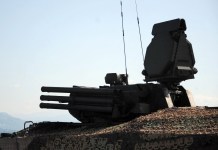India’s first Indigenous Aircraft Carrier (IAC-1) Vikrant is going for Basin Trials this month, with reports stating that the sea trials will follow in December. The 40,000-tonne warship will be tested for propulsion, transmission and shafting systems during the trials, which were earlier scheduled for September but were delayed due to the pandemic.
Indian Navy Wants Three Aircraft Carriers To Counter China; Will Modi-Government Concede To Demands?
It will now take a year more before the mega-ship is commissioned into the Indian Navy, after which the flight trials will make it ready for battle.
The delay in the induction of the carrier now seems to extend until early 2022 – something the country can hardly afford amidst the current stand-off with China.
IAC-1 is expected to be equipped with a short take-off barrier arrested design (STOBAR), similar to India’s already operational INS Vikramaditya, but will field a slightly smaller air wing in terms of numbers.
The Indian Navy has been aggressively pushing for a third aircraft carrier for a long time, especially after Chief of Defence Staff (CDS), General Bipin Rawat, in February this year indicated the government may not grant approval for the third carrier for now.

His remarks alarmed the Indian Navy, which has been consistently maintaining that its overall strategy is centred around the operation of Carrier Battle Groups (CBGs) supported by multi-dimensional surface and air platforms to ensure a decisive edge over the adversary.
The Navy has been demanding for three aircraft carriers to ensure at least two are operationally available at any given time, deploying one for the eastern seaboard and another for western seaboard. The Navy Chief Admiral Karambir Singh has been unrelenting in his demand for the third carrier with the government, particularly, after increasing Chinese patrolling in the IOR region in recent times.
The defence ministry is citing the exorbitant cost involved in the construction of the proposed third 65,000-tonne aircraft carrier IAC-II, which will be the largest ship ever built in the country.
The CATOBAR (catapult assisted take-off but arrested recovery) type IAC-2 is expected to cost upwards of Rs 70,000 crore, without the aircraft. The Navy went to the extent of doing away with the nuclear-propulsion to bring down the cost to Rs 45,000 crore. However, the government seems unimpressed with the proposal.
The force is, however, hopeful that with the current tensions with China, the government could give a go-ahead to the much-awaited third aircraft carrier.
According to reports, the Chinese Navy (PLAN) has already deployed six to seven warships in the IOR and will add a CBG in the region soon, with one more CBGs expected by 2028, creating a power imbalance in the region.
China’s goal is to have 10 carriers by 2050, which should be a cause of concern for India.
Carrier Battle Groups are a formidable force, supported by multiple frigates and destroyers, onboard fighter aircraft and even submarines. A CBG possesses the adequate offensive capability to deliver decisive effect, acting almost like an airbase in itself, representing a potent power projection platform. With India’s vast coastline exposed to the oceans, it remains profoundly vulnerable.
Therefore, the demand of the Indian Navy for three aircraft carriers is legitimate and reasonable, experts believe. Even if the CBGs never actually participate in a way, they have an exceptionally high deterrence value, discouraging any hostile nation to engage with the country deploying them.
The argument being made about the exceptionally high costs associated with the construction of the aircraft carriers often misses the key aspects of how the whole process helps the country itself. Firstly, a large amount of money spent goes back into the economy in a lot of ways and provides employment opportunities to a large number of people.
The project is indigenous and will, therefore, usher in innovation and build valuable experience among the ship-builders.
Moreover, the expenditure will spread over a period of ten years as the carrier is being built and will not need a one-time payment. Finally, considering the carriers have a lifetime of about 50-60 years, the investment will be worth considering.
The government’s argument over costs is also rather confusing because it seems to be very ambitious of achieving a $5 trillion economy as early as 2025. Stalling a project like indigenous aircraft carrier (IAC-3), which is indispensable for the country’s security, is, therefore, puzzling.
The key for the government is to think long term. The current economic situation in India is grim, but it won’t remain so in the coming years. If India aspires to be the net security provider in the IOR, it will need a powerful Navy, with the ability to meet the political and strategic aspirations of the country.
Younis Dar, Srinagar/New Delhi




